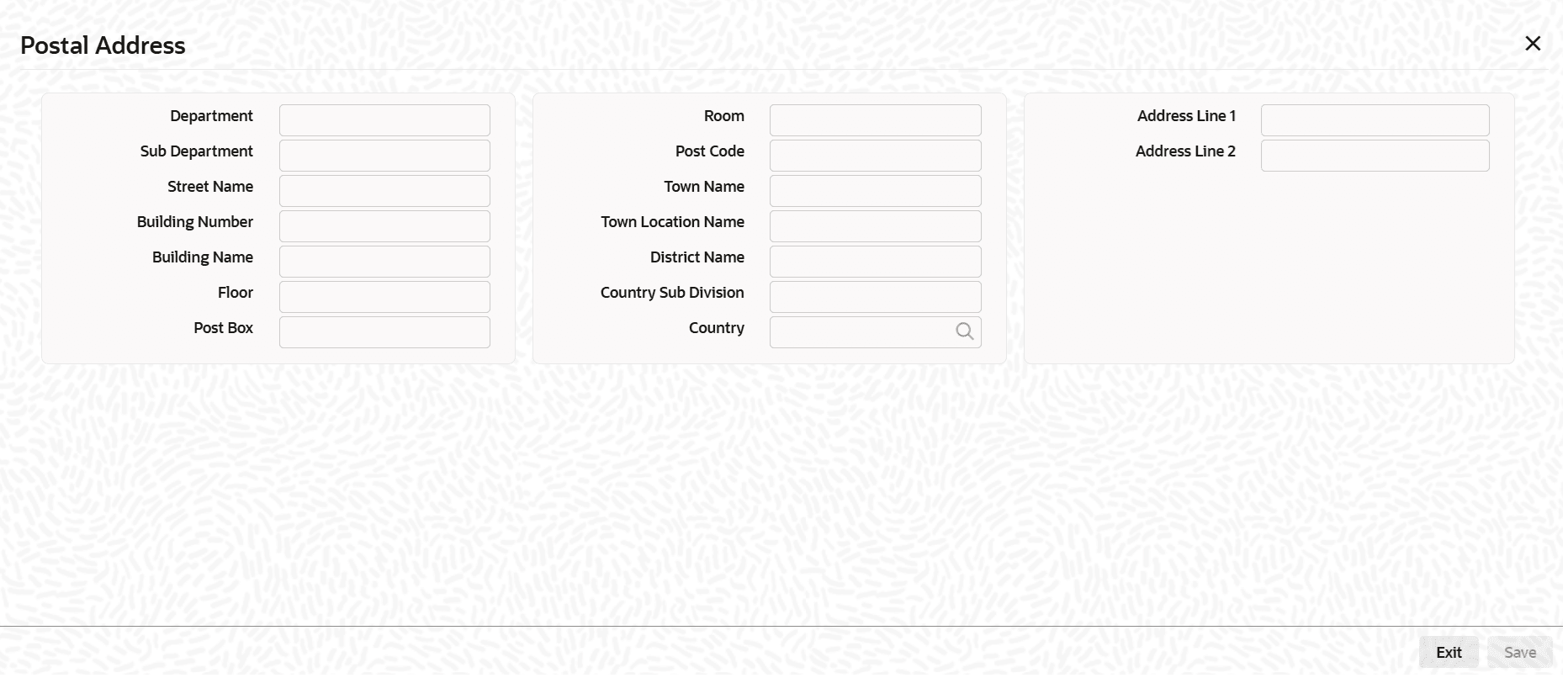1.1.1.2 Postal Address
This topic describes about the Postal Address.
- Click the Postal Address button.The Postal Address screen displays.
- Click Ok to Save or Exit to close the screen.
For information on fields, refer to the below table.
Table 1-4 Postal Address - Field Description
Field Description Structured Address This section displays the following fields to specify the structured address. Department Specify the department. Sub Department Specify the sub department. Street Name Specify the street name of the branch. Building Number Specify the building number of the branch. Building Name Specify the building name of the branch. Floor Specify the floor of the branch. Post Box Specify the post box of the branch. Room Specify the room of the branch. Post Code Specify the post code of the branch. Town Name Specify the town name of the branch. Town Location Name Specify the town location name of the branch. District Name Specify the of the branch. Country Sub Division Specify the country sub division. Country Specify the country of the branch. Hybrid Address This section displays the following fields to specify the hybrid address. Address Line 1 Specify the address for the branch. Address Line 2 Specify the address for the branch. In ISO20022, postal addresses can be represented in two main formats: structured and hybrid.
Structured AddressStructured address data refers to a standardized format for representing location information, typically comprising distinct components, such as street name, post code, town and country details.
This option allows using up to 14 qualifiers for the Address components and requires a minimum of the Town Name and Country to be included in a structured format.Hybrid Address: (semi-structured)- Each component is captured in a separate data field, allowing for precise and consistent representation.
- This format is beneficial for automated processing and validation, as it enables systems to easily parse and verify individual address elements.
- Structured addresses are particularly useful for cross-border transactions where address formats may vary significantly.
As of November 2025, a Hybrid option will be allowed. This means that the address can include both structured and unstructured elements with a minimum of structured Town Name and Country.
This format offers a balance between the flexibility of unstructured addresses and the benefits of structured data for certain key fields.- Hybrid addresses are useful when the address cannot be fully captured in a structured manner or when dealing with jurisdictions that have complex or non-standard address formats.
- The new hybrid (semi-structured) postal address mandates Town Name and Country as a minimum in their respective structured elements, and up to two occurrences of the unstructured address line elements of maximum length 70 characters (2*70) are permitted. Other structured elements in addition to Country and Town Name may also be included. Example, Post Code.
-
The structured address information provided on Town Name and Country must not be repeated in the Address Line elements.
For parties Ultimate Debtor, Ultimate Creditor, and Initiating Party a fully unstructured postal address will never be permitted for these during any time. It must be Structured or Hybrid
Note:
By November 2026, the Unstructured option will be phased out, and all address fields will need to be in a structured or hybrid format.Note:
Postal address capturing is supported for all settlement parties and receivers. When maintained at ISDTRINS postal details will auto default to settlement subsystem.
Parent topic: Settlement Instructions Maintenance
